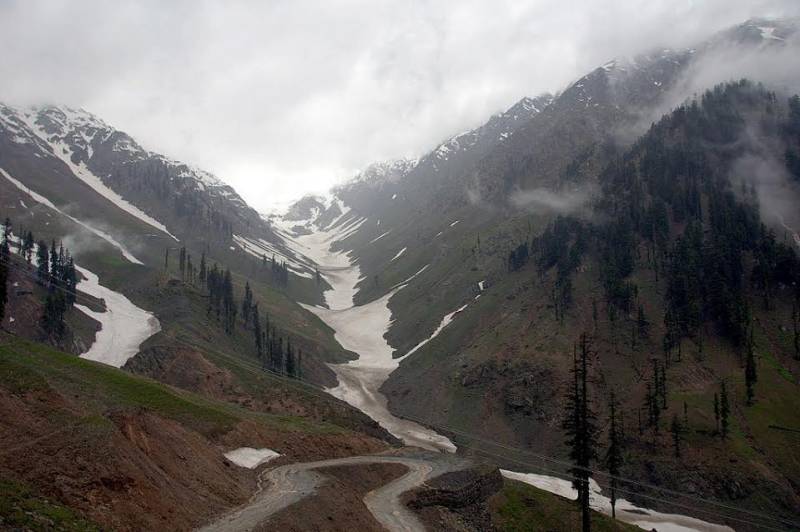A beautiful night had fallen in the capital. I was sitting on the stairs of Pakistan Monument in the heart of Islamabad. There’s this beautiful angle from where you can see the city’s all famous landmarks. Up on the hills a galaxy of lights from the famous restaurant Monal, the white pyramid and minarets of the Faisal Mosque and the illuminated triplet towers of Centaurs Mall. Not to mention the worth dying for night view of the city, which looks like all the stars from heavens have fallen on earth. Weather was absolutely marvelous. It had rained a little in the evening and a gentle, intoxicating breeze was blowing. This time, I had left home for Chitral, the valley famous for its beautiful landscape and colorful culture in the far north western region of Pakistan, close to Afghan border. I had come back from Skardu just a couple of weeks before. I hadn’t taken two trips in such a short time before. Also one of our friends excused himself a few days before. For some time I wasn’t sure if it’s a good idea to take this trip. But I listened to my heart and went on with it. So, on that beautiful night in Islamabad, we were sitting on the stairs of Pakistan Monument waiting for my cousin Haris who was to convey us to I-8 Markaz where the buses for Chitral were waiting for us. We were going to travel with Discover Pakistan.
Haris loves travelling but he has never left home. He starts dreaming whenever he watches Pakistan’s northern areas on the screen and keeps dreaming because he has a terrible katsaridaphobia (fear of cockroaches). For me, Islamabad is not Islamabad without him and he never allows me to pass by the city without seeing him. Besides, who wouldn’t like to save the taxi fair? So he picked us up from the monument. We drove down to Islamabad highway through a beautiful forest road and landed at a naan joint in F-10 which is run by the students of NUST. Haris’ extreme sense of hospitality wouldn’t let us pass through his hands without getting us something to eat even if we were getting late and wanted to avoid eating while travelling. We finally reached I-8 Markaz and spotted the coasters and gathering of Discover Pakistan. With a hello to our new travelling companions and a good bye to Haris, we settled on the back seat of a coaster.
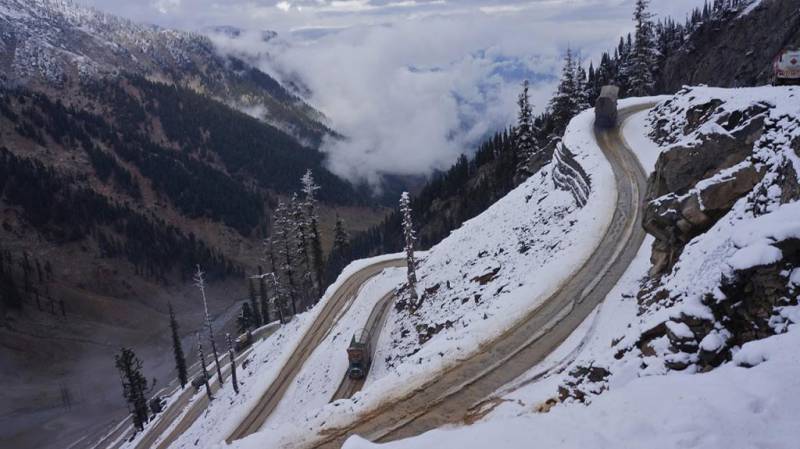
Road to Lowari Top
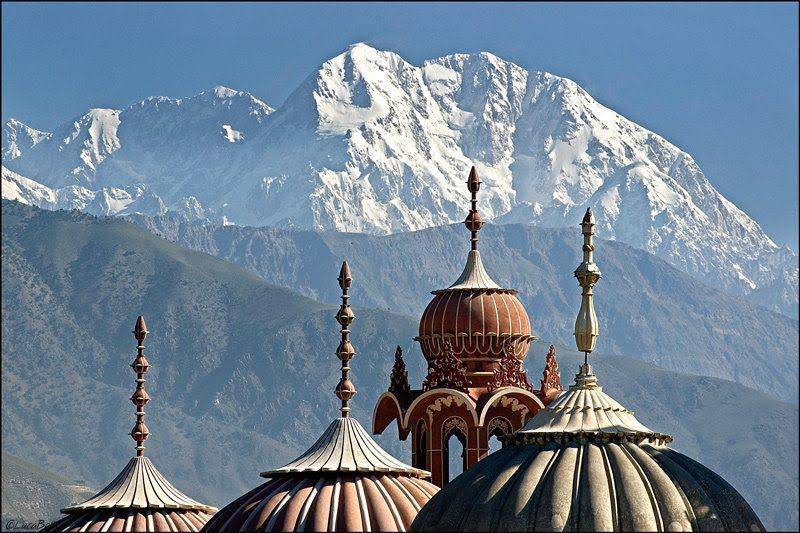
The great mountain Terich Mir from Chitral
After signing a document which took assurances that the tour company would remain safe from any extra responsibility or litigation, the coasters rolled and we headed towards the motorway. There was a pulse of excitement in the coaster. A group of girls sitting at the center proposed that we should all introduce ourselves because the journey is long and destination is far. It turned out to be a very diverse and interesting lot. They had come from all over Pakistan, from Islamabad and Lahore to as far as Quetta and Karachi. Ages varied from university undergrads to ladies and gentlemen well into their late 50s and 60s. We left the motorway late into the night and took a break at Mardan in front of Bacha Khan University. The city was quiet and streets were deserted at this hour. Just a roadside restaurant was open and serving hot food. Some of us went inside the restaurant, others stood by the road. A group of local lads from the university had just returned from a trip to Swat. We shared a word or two. They were very pleasant and friendly. I saw one of our female group members wearing western clothes, enjoying a smoke standing by the road at this hour in the notorious city of Mardan. It was such a liberating sight. Travelling itself is liberation, from the usual. By dawn we were travelling in the beautiful valley of Lower Dir. River Chitral was flowing in the opposite direction and its fertile banks were lush green with vegetation. We made another stop over at a motel in Dir for breakfast around 7 in the morning and resumed our journey on the beautiful road towards Chitral. In Upper Dir, the road gradually started gaining height. The valley became narrower and the river was flowing deep inside it. Soon, we spotted a gigantic opening of a tunnel. Bab-e-Zulfiqar (The Zulfiqar Gate) was written on top of it in bold words. It was opening to the famous and still unfinished Lowari Tunnel attributed to former Prime Minister Zulfiqar Ali Bhutto. A huge and apparently impregnable mountain range stands between Chitral and the rest of Pakistan. Natural and easier route to Chitral is through Afghanistan. The only land route is through Lowari Pass, a very dangerous road which winds its way to the top of the mountain and down towards Chitral. The road is only functional during summers. Harsh winters disconnect Chitral from the rest of the country. A tunnel through the mountains was planned by Bhutto government in 1970s. Unfortunately, the work on tunnel is still not finished after forty years. The traffic is allowed inside the tunnel only during winters. In summers, it is open only for emergencies or VIPs. Since we were neither, we left the tunnel behind and moved on to climb the Lowari Pass, fifth most dangerous road in the world. Temperature decreased as we gained more and more height. The road makes its way in coils like a giant snake slithering over the mountain. It is mostly narrow and muddy with sharp dangerous turns. Two vehicles cannot easily cross each other. There is no question of a barrier or a protective fence. All you see from the window is steep depth of the valley and loops of the dangerous road you have just covered. At a few scary turns there’s nothing but clear blue sky ahead. Huge siding rocks had stopped just a few meters above the road. Greenery becomes scanter and scanter as you gain height. The road offers a mesmerizing view of snow capped mountains. At times, the road disappears beneath glaciers and fast flowing streams. We vacated coasters a couple of times to cross the streams on foot. I stayed inside the coaster for one such crossing. The driver almost flew across the stream and they were the bumpiest two minutes of the whole trip. A check post and signal towers indicated that we had finally reached Lowari Top. It was very cold at the top. The sky was thick with clouds and a light drizzle started. After such a difficult journey and absolutely mesmerizing panoramic scenes at the top, one feels like reaching heavens. Coasters slowly started descending on the other side of the mountain. It was quite misty. The road was very dangerous but we didn’t feel it inside the vacuum of the coaster and the heat of our interesting conversations. Because I was sitting beside the window at the far back, I saw we were really close at a few turns. Small dwellings appeared as we neared the end of Lowari Pass. It took us nearly five hours to cross the mountain pass. Down in the valley we stopped by a bunch of odd looking shops and eateries which seemed to be the only sign of civilization for miles. Some of us stood by the road before it started raining heavily and everyone took shelter inside a small Afghan eatery. Charpoys and tables were laid inside a dark hall with an open kitchen. I had the most delicious Afghani Pulao and a nice cup of raw tea before we resumed our journey towards Chitral.
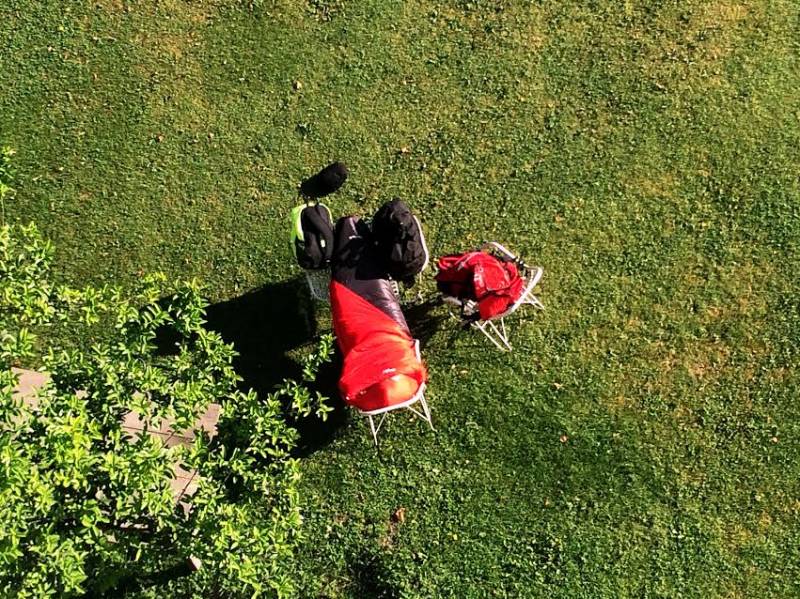
A traveler slept in the lawn in his sleeping bag
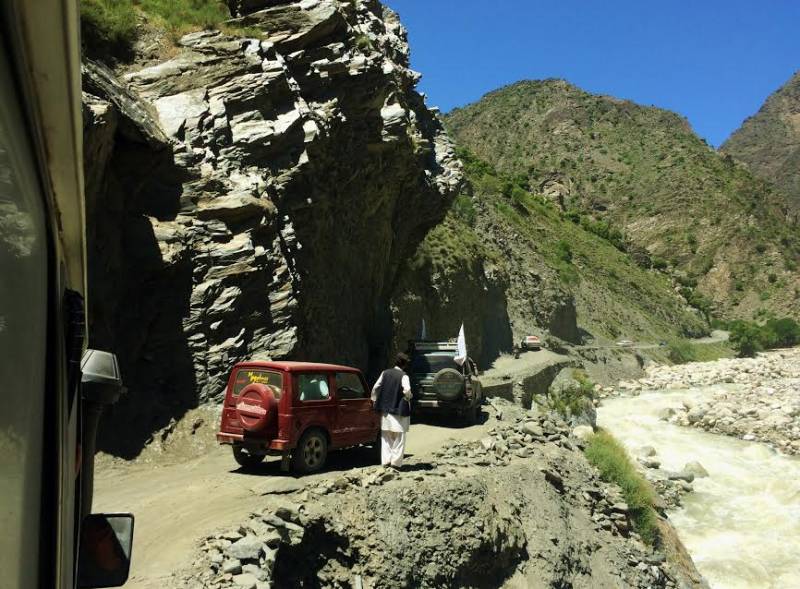
Dangerous road to Bombarete
The rain didn’t stop for the next few hours. All the way to Chitral, we travelled through beautiful green valleys. Window of the coaster repeatedly got smoky and I had to clear them to get a view of the world outside. A few villages and settlements were adjacent to the road, others were scattered over the valley alongside the river bank. There was a lot of greenery and a lot of pomegranate tress full of blossoms. We made a brief stop at the view point of Bombarete Valley. It is hard to describe the serenity and beauty of that scene. The river was zigzagging its way through the valley. Small houses scattered over the valley looked like dots from this far. Lush green valley surrounded by half green and half brown mountains, a typical landscape of the entire region around Chitral.
We finally reached Chitral a little before sunset. It’s a simple under developed town lost in its isolation from the rest of the country. Making our way through the bazaars, we reached the hotel Terich Mir View, which was owned and run by Chitral’s royal family. Its walls were packed with portraits of local elders, Chitrali handicrafts and posters of the tourism department. After nearly 22 hours on the road, we sat in the spacious lobby of the hotel and waited for room allocation. It turned out that some groups which included us were going to stay at Marakha Inn, a small rest house at five minutes’ walk from the hotel. The entire modern history of Chitral could be seen in those five minutes because the hotel and the rest house were only separated by Chitral’s Royal Mosque and Old Fort. We settled at room 106 of the Marakha Inn and got Sher Ali as our roommate. He is an excellent photographer known by his blogging name ‘The Silent Traveler’. Professionally he’s a software engineer and ethnically a tribal Pathan. We became friends and spent the next three days travelling, talking and laughing. The dinner was served at the hotel after which we took much needed rest.
The next morning, on our way to the hotel for breakfast we noticed our surroundings for the first time in daylight. There was a huge sports field in front of the Royal Mosque and the Fort. A passage shaded with trees led to the closed gate of the Fort and beautiful multi color roses were blooming in a spacious garden in front of the Royal Mosque. It was a beautiful example of later Mughal architecture.
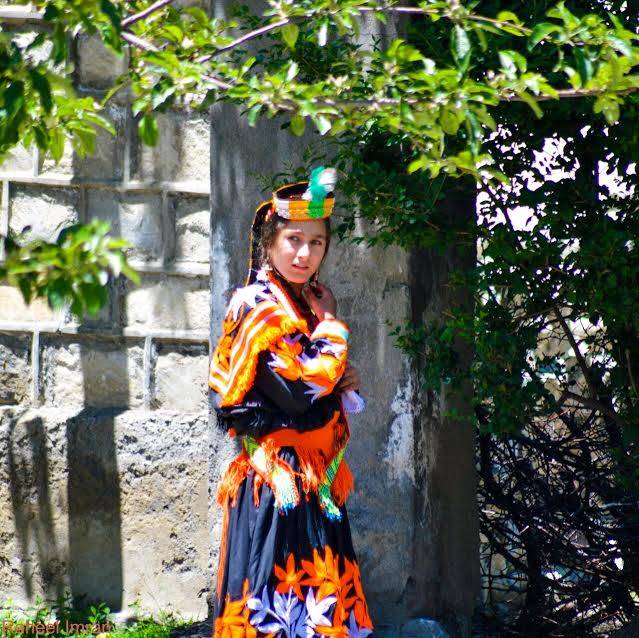
A Kalash girl
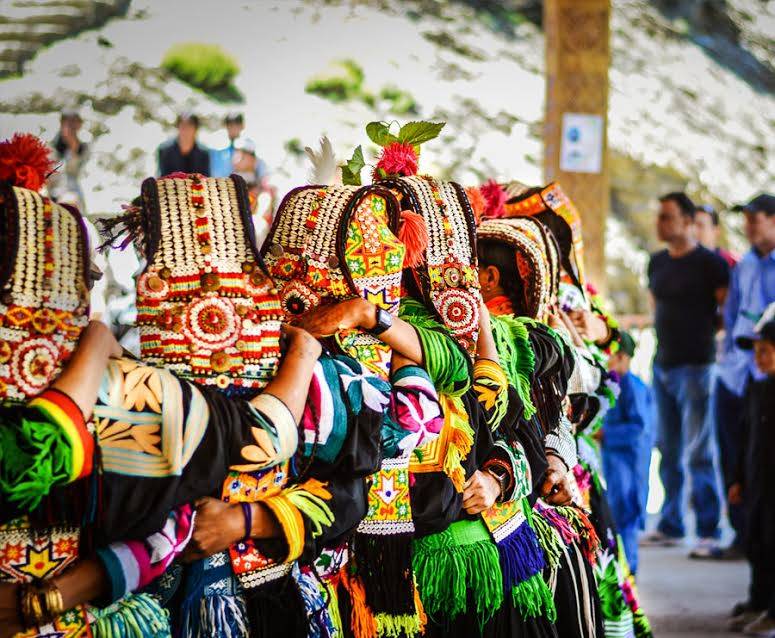
Kalash woman dancing at Chilam Joshi festival
Breakfast was served in the spacious dining hall at the hotel. Its balconies gave a spectacular view of the river, the valley and far behind other mountains, the mighty Terich Mir. It is the highest mountain of the Hindukush range measuring 7,700 meters from the sea level. After many moments of appreciating the beauty of the great mountain, I spotted something odd right beneath the balcony. In the garden, a tourist wrapped in a red and black sleeping bag, was sleeping in a chair with his legs on the table. His luggage occupied another chair. Truly, passion knows no bounds. After breakfast, we boarded wagons and started the journey towards Kalash Valley to witness the world famous Chilam Joshi festival. Back on the highway, we had our first absolutely beautiful and panoramic view of the mighty Terich Mir. There are quite a few valleys and mountains between Chitral and Terich Mir so it looks quite distant from the town. From the road, it was quite clear and close, standing with all its grandeur. The mountain is an enormous and impressive white mass set against a blue sky. It looked like a lot of rocks and snow fell from God’s hands when he was creating Terich Mir. Its beauty is in its loneliness among grayish brown mountains. We crossed a bridge over the river and started journey towards Bombarete on a very dangerous road.
It was more of a bumpy mud path carved out of mountains and there was barely room for two vehicles to cross each other. At times the carved rocks made a roof over the road and there were just a few inches of road between wagon wheels and certain death. For some time there were settlements, fields and villages along the road. Homes were made of intricate stonework and lifestyle was purely agrarian. As we moved on, signs of civilization became scarce and terrain became more and more wild and uninhabited. The river made its way through gray mountains. There was a serene loneliness in the air as if we were the first explorer to this part of the world. After some four hours on the road and tricking some very dangerous turns and half broken bridges, we finally reached Bombarete where the Chilam Joshi festival was being celebrated. The place is one little habitation in the middle of wilderness. Great snow capped mountains shadow over the valley and a roaring river flows through it. The Kalash tribe inhabits eastern bank of the river. As we neared Bombarete, we could hear a distant sound of singing and beating drums, a sign that festivities had started. Women of all ages dressed in traditional Kalash attire were making their way through the fields to the festival. Their gowns and crowns were made of thousands of bright colorful beads sewn in the black fabric. At the first glance, they looked like peacocks roaming in the fields. Kalash men were dressed simply. They wore colorful sashes and their caps were adorned with bird feathers or roses.
We parked near Kalash Museum; an impressive structure built in collaboration with Greece, and walked a little to reach the celebration ground which was an open place in the center of the village. Hundreds of Kalash men and women, dressed in their traditional costumes were dancing to celebrate the spring season. It was a world of bright colors, as if spring had manifested in the form of merry making Kalash tribe. There were literally thousands of spectators of this wonderful sight. The Kalash tribe, immersed in their celebrations and oblivious of spectators, danced on. Surprisingly, genders mix freely in the Kalash tribe. The norm of greeting is kissing hands even among young men and women. They danced to a rhythmic beating of drums and made a peculiar sound which had a strange musical quality. That day, they were the happiest people on earth, celebrating life and its beautiful colors. They danced in different enchanting patterns. Ladies would make a line by putting their arms around each other’s waists and men would do the same. The female line would move in semi circles surrounded by the male line. Then the pattern would change; both lines facing each other would rush like two waves and revert back a few inches from the other line. When the dance was concluded, the performers rushed towards a small tree and plucked all its leaves leaving the branches naked.
There are several popular myths regarding the origins of Kalash tribes, the most popular of which is that they are one of the lost tribes mentioned in ancient texts. Another popular theory is that they were descendents of Greek soldiers from the armies of Alexander the Great who chose to remain in the area and never went back home. Kalash remained in isolation from the outer world for thousands of years, unaffected from political and spiritual upheavals occurring in its surrounding regions. When they were finally discovered, their unique culture and distinct way of life became a fascination for outsiders. However, the discovery of Kalash was also the beginning of its end. The road did not just bring tourists and explorers; it paved way for the outer world to sink in. Kalash dancing troupes were taken abroad to perform. Today, there’s a mosque in the village and pagans have converted to Islam in huge numbers. The Kalash women wear their traditional attire only on festival days. They have cell phones and laptops. Young Kalash men and women study in top universities all over Pakistan. With greater connectivity with the outer world, things are changing for the Kalash tribe. They are gradually abandoning their tribal culture for a modern life. In the face of this massive transformation which is bound to annihilate this culture, it was very thoughtful to build a museum dedicated to the tribe. Entire Kalash houses with complete furnishings, utensils and accessories have been preserved in the museum. Other sections display ancient weapons, musical instruments and vintage photographs of the tribe. All these items are worth looking at.
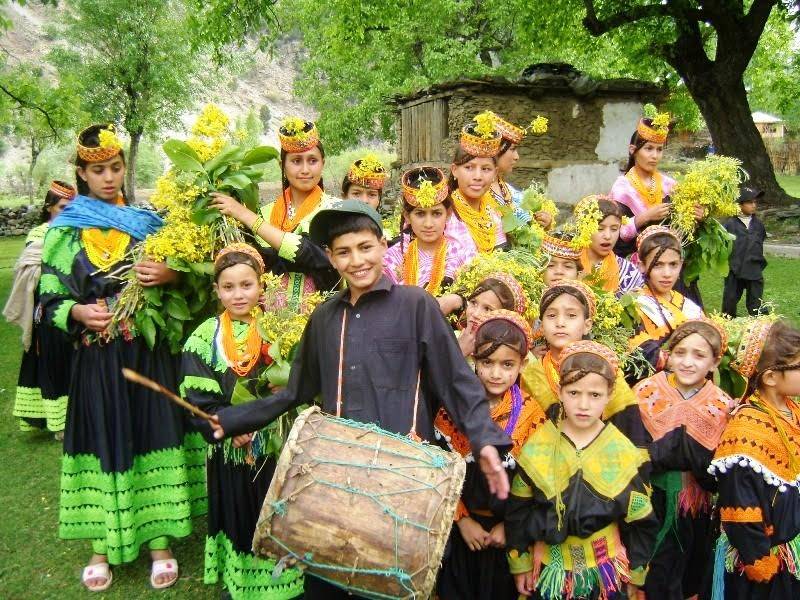
Kalash children celebrating
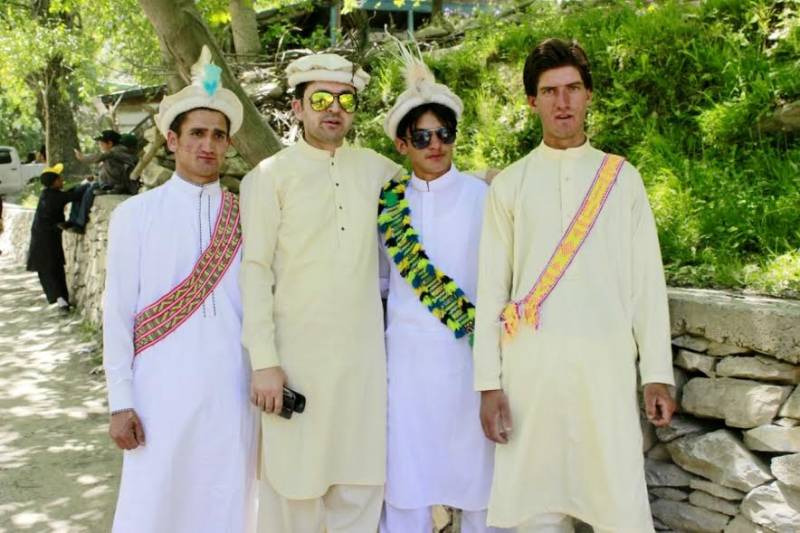
Kalash men
According to an estimate, nearly 7,000 people travelled between Chitral and Bomberete that day to witness the beautiful Chilam Joshi festival. We left for Chitral in the afternoon. We had great company in the wagon. Other than Sher Ali, our immediate companions were a couple and their daughter from Islamabad. Dr and Dr. Shahid were the loveliest old couple I had ever met and making their acquaintance was a complete pleasure. In their late 50s, they were more young at heart and enthusiastic about life than many seventeen year olds. They had an unusually good sense of humor. Their daughter Aamna is an artist. She made sketches in her little sketchbook. Another lady with a very, very young heart was Ms. Uzma. She was a senior teacher and a travel enthusiast. She was accompanied by her student Ibrahim, who turned out to be an old boy of my school. As soon as we took the road out of Chitral, we started talking and laughing like old friends and at the end of those two days, we were just like a family. That day on our way back from Bomberete, we discovered that the whole group had fine vocal cords and nearly everyone managed to sing a song when their turn came.
That night the dinner was served in the garden of Terich Mir View Hotel. We stayed there till after midnight. Different groups were chatting and laughing and a bunch of losers were trying a hand at pathani dance. Bright stars were looking down at us and life was infinitely beautiful.
Continued…

